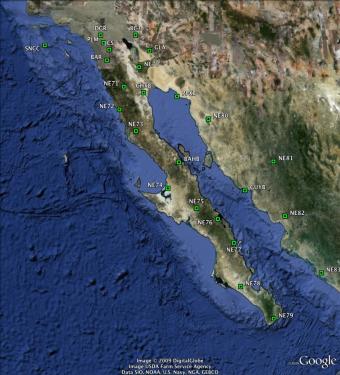PROVIDENCE, R.I. [Brown University] — Imagine the Earth’s crust as the planet’s skin: Some areas are old and wrinkled while others have a fresher, more youthful sheen, as if they had been regularly lathered with lotion.
Carry the metaphor a little further and a good picture emerges of the geological processes leading to the creation of the planet’s crust. On land, continental crust, once created, can remain more or less unaltered for billions of years. But the oldest oceanic crust is only about 200 million years old, as new crust is continually forming at midocean ridge spreading centers.
While geologists have known that oceanic crust continually replenishes itself, they have been unsure what occurs below the surface that leads to the resurfacing. What geodynamics are occurring in the mantle that eventually produces new crust, that new layer of skin on the ocean’s bottom?
The answer has been elusive in part because oceanic crust is difficult to reach and instruments that can measure seismic activity have not fully covered the terrain to obtain an accurate picture of forces below the surface. Now earth scientists led by Brown University have observed — in detail and at unprecedented depths — a geological phenomenon known as dynamic upwelling in the underlying mantle beneath a spreading center. Their findings, reported in this week’s Nature, may resolve a longstanding debate regarding the relative importance of passive and dynamic upwelling in the shallow mantle beneath spreading centers on the seafloor.
“We know the crust of the ocean is produced by upwelling beneath separating plates,” said Don Forsyth, professor of geological sciences at Brown. “We just didn’t know the upwelling pattern that took place, that there are concentrated upwelling centers rather than uniform upwelling.”
Mantle upwelling and melting beneath spreading centers has been thought to be mostly a passive response to the separating oceanic plates above. The new finding shows there appears to be a dynamic component as well, driven by the buoyancy of melt retained in the rock or by the lighter chemical composition of rock from which melt has been removed.
The scientists from Brown and the University of Rhode Island based their findings on a high-resolution seismic study in the Gulf of California. In that region, there are 25 seismometers spaced along the western coast of Mexico and the Baja California peninsula, which lie on either side of the Gulf of California. Yun Wang, a Brown graduate student and the paper’s lead author, tracked the velocity of seismic waves that traveled from one station to another. She noticed a pattern: The seismic waves in three localized centers, spaced about 250 kilometers (155 miles) apart, traveled more slowly than waves in the surrounding mantle, implying the presence of more melt in the localized centers and thus a more vigorous upwelling. From that, the geologists determined the centers, located 40-90 kilometers (25 to 56 miles) below the surface, showed evidence of dynamic upwelling in the mantle.
“We found a pattern that was predicted by some of the theoretical models of upwelling in midoceanic ridges,” Forsyth said.
While other studies have been done of mantle geodynamics, most notably an experiment on the East Pacific Rise, the Brown-URI study imaged seismic activity, or the shear velocity of the seismic waves, some 200 kilometers (124 miles) below the surface — a far deeper seismic penetration into the mantle than previous experiments.
Brian Savage, assistant professor of geophysics at the University of Rhode Island and a contributing author on the paper, said the finding is important, because it helps to provide “a basic understanding of how a majority of the earth’s crust is formed, how it emerges from the mantle below to create the oceanic crust. It's a basic science question that helps understand how crust is created.”
The research was funded by the National Science Foundation.

